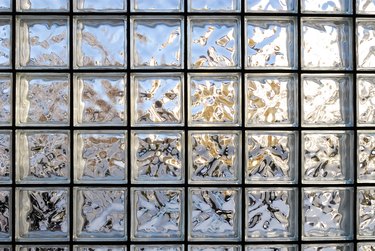
The main drawback of glass block windows in the shower is they don't open. Without a window that opens in the bathroom, steam and moisture build up, making it a haven for mold and mildew growth, and most local building jurisdictions require some kind of ventilation for bathrooms. Add to that a poor quality installation, and you can have a host of problems that make you want to tear out the glass blocks and start all over again. Make sure you know all the correct information and procedures before you start installing the glass blocks.
Safety Issues
Video of the Day
Before adding glass blocks to a window in your shower or as a dividing wall between the shower and the rest of the bathroom, check local building codes, because each building jurisdiction administers the standards for construction in its region. The local code determines the type of glass required in places where people can slip or fall against glass windows. Traditional mortared glass block commonly is considered masonry rather than glazing, but check your local code to be sure. Additional code requirements may dictate specific waterproofing measures and other construction details.
Video of the Day
Installation Issues
Glass block windows are tricky to install. Each row must be installed level and flat. Any deviation, even a small one, can offset a whole course of blocks and ruin the finished look. As you install each glass block, verify it is level and that it aligns with the other glass blocks previously installed. Or -- for best results -- buy a glass block window approved for bathroom use that's installable as one unit so you don't have to position the individual glass blocks.
Water Leaks
A grout material -- installed in a manner similar to the method for bricks or tile -- fills in the space between the blocks. If the blocks are not installed correctly, and miniature air gaps developed during the installation phase, water can permeate the grout and cause leaks. In a second-story bathroom with a glass block window or window wall, this can cause serious damage below, which may not be noticed until it's too late. Add a sealant that penetrates the grout in such a way that it forms a moisture barrier. Reapply the sealant as needed, or as recommended by the manufacturer to ensure the grout stays dry.
Mold and Mildew
A bathroom without a source for venting steam generates a lot of moisture that contributes to mold and mildew growth. The grout between the individual glass blocks offers a source for such growth, especially since it's porous and has no backing to stop the moisture from traveling through it. To prevent mold and mildew growth, clean the grout regularly and wipe up excess moisture with a towel after showering. If you do not have a window you can open in the bathroom, install an exhaust fan to blow shower steam outside to keep mold and mildew growth to a minimum.
Water Stains
Even though you can't see through glass blocks, hard water can still leave its mark on glass blocks, making them appear dingy. If you use well water instead of a municipal water supply, hard water combined with iron or other minerals can leave glass blocks with rusty, black or hard-water stains. Run a squeegee over the glass after showering, or wipe it down with a towel. Clean the glass blocks weekly with a 50-50 ratio of vinegar and water with a few drops of dish detergent added to a spray bottle to reduce fogging and keep water stains from forming.
- Grimm Modern Building Material Co., Inc.: Installing Glass Block Windows
- Ask the Builder: Glass Block
- Family Handyman: How to Install a Glass Block Shower
- Pittsburg Corning: Select the Pittsburg Corning Glass Block Pattern That Best Suits You and Your Home
- The Journal of Light Construction: Glass-Block Shower Window
- Home Depot: Glass Block Installation